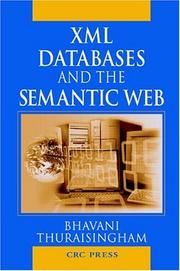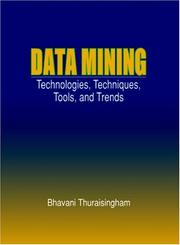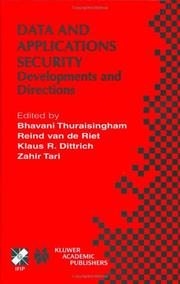| Listing 1 - 7 of 7 |
Sort by
|

ISBN: 0849310318 Year: 2002 Publisher: Boca Raton CRC
Abstract | Keywords | Export | Availability | Bookmark
 Loading...
Loading...Choose an application
- Reference Manager
- EndNote
- RefWorks (Direct export to RefWorks)
Database management --- Semantic Web --- Web site development --- XML (Document markup language) --- 681.3*H --- 681.3*H Information systems --- Information systems --- Extendible Markup Language (Document markup language) --- eXtensible Markup Language (Document markup language) --- Document markup languages --- Development of Web sites --- Web sites --- Internet programming --- Semantic integration (Computer systems) --- Semantic networks (Information theory) --- World Wide Web --- Microformats --- Data base management --- Data services (Database management) --- Database management services --- DBMS (Computer science) --- Generalized data management systems --- Services, Database management --- Systems, Database management --- Systems, Generalized database management --- Electronic data processing --- Development --- XML (extensible markup language)

ISBN: 0849318157 Year: 1999 Publisher: Boca Raton CRC
Abstract | Keywords | Export | Availability | Bookmark
 Loading...
Loading...Choose an application
- Reference Manager
- EndNote
- RefWorks (Direct export to RefWorks)
Book
ISBN: 1003081843 1003081843 1000557502 1000557510 Year: 2022 Publisher: Boca Raton, Florida ; Abingdon, Oxon : CRC Press,
Abstract | Keywords | Export | Availability | Bookmark
 Loading...
Loading...Choose an application
- Reference Manager
- EndNote
- RefWorks (Direct export to RefWorks)
Secure data science, which integrates cyber security and data science, is becoming one of the critical areas in both cyber security and data science. This is because the novel data science techniques being developed have applications in solving such cyber security problems as intrusion detection, malware analysis, and insider threat detection. However, the data science techniques being applied not only for cyber security but also for every application area--including healthcare, finance, manufacturing, and marketing--could be attacked by malware. Furthermore, due to the power of data science, it is now possible to infer highly private and sensitive information from public data, which could result in the violation of individual privacy. This is the first such book that provides a comprehensive overview of integrating both cyber security and data science and discusses both theory and practice in secure data science. After an overview of security and privacy for big data services as well as cloud computing, this book describes applications of data science for cyber security applications. It also discusses such applications of data science as malware analysis and insider threat detection. Then this book addresses trends in adversarial machine learning and provides solutions to the attacks on the data science techniques. In particular, it discusses some emerging trends in carrying out trustworthy analytics so that the analytics techniques can be secured against malicious attacks. Then it focuses on the privacy threats due to the collection of massive amounts of data and potential solutions. Following a discussion on the integration of services computing, including cloud-based services for secure data science, it looks at applications of secure data science to information sharing and social media. This book is a useful resource for researchers, software developers, educators, and managers who want to understand both the high level concepts and the technical details on the design and implementation of secure data science-based systems. It can also be used as a reference book for a graduate course in secure data science. Furthermore, this book provides numerous references that would be helpful for the reader to get more details about secure data science.

ISBN: 0262280175 0585444757 9780262280174 0262133849 9780262133845 9780585444758 0262632616 Year: 2000 Publisher: Cambridge, Mass. MIT Press
Abstract | Keywords | Export | Availability | Bookmark
 Loading...
Loading...Choose an application
- Reference Manager
- EndNote
- RefWorks (Direct export to RefWorks)
This book provides an introduction to the field of knowledge management. Taking a learning-centric rather than information-centric approach, it emphasizes the continuous acquisition and application of knowledge. The book is organized into three sections, each opening with a classic work from a leader in the field. The first section, Strategy, discusses the motivation for knowledge management and how to structure a knowledge management program. The second section, Process, discusses the use of knowledge management to make existing practices more effective, the speeding up of organizational learning, and effective methods for implementing knowledge management. The third section, Metrics, discusses how to measure the impact of knowledge management on an organization. In addition to the classic essays, each section contains unpublished works that further develop the foundational concepts and strategies.
Knowledge management. --- Management of knowledge assets --- Management --- Information technology --- Intellectual capital --- Organizational learning --- BUSINESS/Management --- Documentation and information --- Theory of knowledge --- Organization theory --- Artificial intelligence. Robotics. Simulation. Graphics --- Knowledge management --- 65.012.4 --- 65.012.4 Management. Directorate. Technique and methods of management --- Management. Directorate. Technique and methods of management --- Gestion des connaissances
Book
ISBN: 3031589238 Year: 2025 Publisher: Cham, Switzerland : Springer,
Abstract | Keywords | Export | Availability | Bookmark
 Loading...
Loading...Choose an application
- Reference Manager
- EndNote
- RefWorks (Direct export to RefWorks)
This Handbook aims to serve as a one-stop, reliable resource, including curated surveys and expository contributions on Federated Learning. It covers a comprehensive range of topics, providing the reader with technical and non-technical fundamentals, applications, and extensive details of various topics. The readership spans from researchers and academics to practitioners who are deeply engaged or are starting to venture into the realms of Trustworthy Federated Learning. First introduced in 2016, federated learning allows devices to collaboratively learn a shared model while keeping raw data localized, thus promising to protect data privacy. Since its introduction, federated learning has undergone several evolutions. Most importantly, its evolution is in response to the growing recognition that its promise of collaborative learning is inseparable from the imperatives of privacy preservation and model security. The resource is divided into four parts. Part 1 (Security and Privacy) explores the robust defense mechanisms against targeted attacks and addresses fairness concerns, providing a multifaceted foundation for securing Federated Learning systems against evolving threats. Part 2 (Bilevel Optimization) unravels the intricacies of optimizing performance in federated settings. Part 3 (Graph and Large Language Models) addresses the challenges in training Graph Neural Networks and ensuring privacy in Federated Learning of natural language models. Part 4 (Edge Intelligence and Applications) demonstrates how Federated Learning can empower mobile applications and preserve privacy with synthetic data.

ISBN: 1280205806 9786610205806 030647008X 0792375149 Year: 2001 Publisher: Boston : Kluwer Academic Publishers,
Abstract | Keywords | Export | Availability | Bookmark
 Loading...
Loading...Choose an application
- Reference Manager
- EndNote
- RefWorks (Direct export to RefWorks)
New technology is always evolving and companies must have appropriate security for their businesses to be able to keep up to date with the changes. With the rapid growth of the internet and the world wide web, data and applications security will always be a key topic in industry as well as in the public sector, and has implications for the whole of society. Data and Applications Security covers issues related to security and privacy of information in a wide range of applications, including: Electronic Commerce, XML and Web Security; Workflow Security and Role-based Access Control; Distributed Objects and Component Security; Inference Problem, Data Mining and Intrusion Detection; Language and SQL Security; Security Architectures and Frameworks; Federated and Distributed Systems Security; Encryption, Authentication and Security Policies. This book contains papers and panel discussions from the Fourteenth Annual Working Conference on Database Security, which is part of the Database Security: Status and Prospects conference series sponsored by the International Federation for Information Processing (IFIP). The conference was held in Schoorl, The Netherlands in August 2000.
Database security --- Data encryption (Computer science). --- Information Systems. --- Information theory. --- Data structures (Computer science). --- Information storage and retrieval. --- Cryptology. --- Management of Computing and Information Systems. --- Theory of Computation. --- Data Structures and Information Theory. --- Information Storage and Retrieval. --- Data structures (Computer scienc. --- Information storage and retrieval systems. --- Data structures (Computer science) --- Management information systems. --- Computer science. --- Computers. --- Information structures (Computer science) --- Structures, Data (Computer science) --- Structures, Information (Computer science) --- Electronic data processing --- File organization (Computer science) --- Abstract data types (Computer science) --- Automatic computers --- Automatic data processors --- Computer hardware --- Computing machines (Computers) --- Electronic brains --- Electronic calculating-machines --- Electronic computers --- Hardware, Computer --- Computer systems --- Cybernetics --- Machine theory --- Calculators --- Cyberspace --- Informatics --- Science --- Computer-based information systems --- EIS (Information systems) --- Executive information systems --- MIS (Information systems) --- Sociotechnical systems --- Information resources management --- Management --- Data encoding (Computer science) --- Encryption of data (Computer science) --- Computer security --- Cryptography --- Communication systems --- Cryptography. --- IT Operations. --- Management.
Book
ISBN: 1479910503 1479926698 Year: 2013 Publisher: New York : IEEE,
Abstract | Keywords | Export | Availability | Bookmark
 Loading...
Loading...Choose an application
- Reference Manager
- EndNote
- RefWorks (Direct export to RefWorks)
Information technology --- Data mining --- Knowledge management
| Listing 1 - 7 of 7 |
Sort by
|

 Search
Search Feedback
Feedback About UniCat
About UniCat  Help
Help News
News